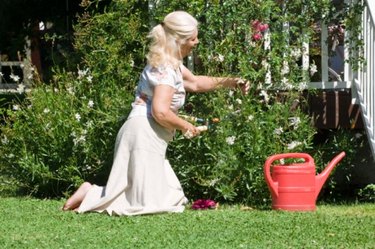
Aucuba japonica -- the gold-dust plant -- is an evergreen shrub happiest in partial to full shade. A landscape plant in mild winter climates, it grows in containers elsewhere. Black areas on aucuba's normally yellow-flecked, glossy green leaves are a sign of trouble.
Aphids and Sooty Mold
Video of the Day
Foxglove aphids (Aulacorthum solani) are tiny, green insects that infest aucuba and suck its stem and leaf juices. They also secrete sticky waste called honeydew. Honeydew attracts the sooty mold fungus. It covers the plants' leaves with a black, powdery mold.
Video of the Day
Sooty Mold Control
Controlling aphids will control sooty mold. Remove the insects, honeydew and black mold with a strong spray of water. Washing the plants early in the day lets them dry quickly and reduces their risk of other fungal infestations.
Sunburn-Blackened Leaves
As shade-loving plants, aucubas often develop black foliage when they receive too much sun. Sunburn appears as brown or black leaf blotches. Damage is heaviest on plants in dry soil and bright afternoon sun.
Sunburn Treatment
Prune the damaged leaves. Transplant the aucuba shrubs -- or move the container plants -- to shady areas. Keep their soil moist.
- UC IPM Online Pests in Gardens and Landscapes: Aucuba - Aucuba Japonica Pests and Disorders
- UC IPM Online Pests in Gardens and Landscapes: Aphids; M.L. Flint; May 2000
- "Ortho Home Gardener's Problem Solver"; Denny Schrock; 2004
- NCSU: Common Disease and Disorders with the Gold-Dust Plant Aucuba Japonica; Tom Creswell et al.